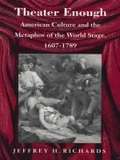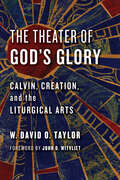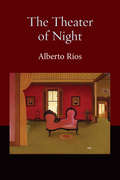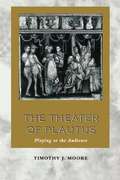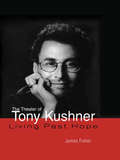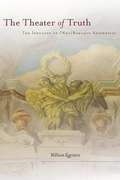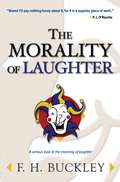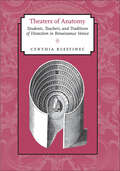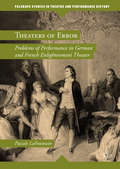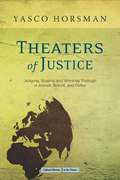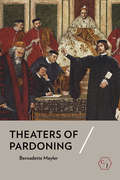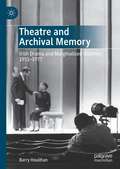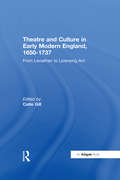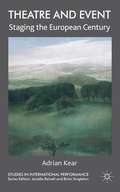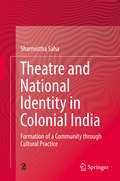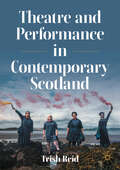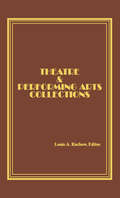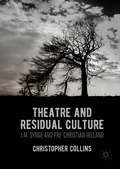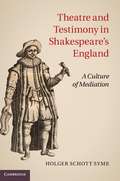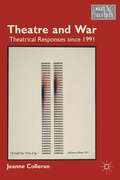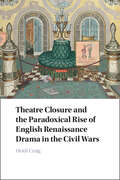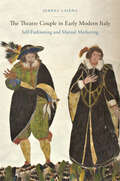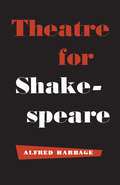- Table View
- List View
Theater Enough: American Culture and the Metaphor of the World Stage, 1607–1789
by Jeffrey H. RichardsThe early settlers in America had a special relationship to the theater. Though largely without a theater of their own, they developed an ideology of theater that expressed their sense of history, as well as their version of life in the New World. Theater Enough provides an innovative analysis of early American culture by examining the rhetorical shaping of the experience of settlement in the new land through the metaphor of theater.The rhetoric, or discourse, of early American theater emerged out of the figures of speech that permeated the colonists' lives and literary productions. Jeffrey H. Richards examines a variety of texts--histories, diaries, letters, journals, poems, sermons, political tracts, trial transcripts, orations, and plays--and looks at the writings of such authors as John Winthrop and Mercy Otis Warren. Richards places the American usage of theatrum mundi--the world depicted as a stage--in the context of classical and Renaissance traditions, but shows how the trope functions in American rhetoric as a register for religious, political, and historical attitudes.
The Theater of God's Glory: Calvin, Creation, and the Liturgical Arts
by W. David TaylorA theological framework for the liturgical arts rooted in John Calvin Both detractors and supporters of John Calvin have deemed him an enemy of the physical body, a pessimist toward creation, and a negative influence on the liturgical arts. But, says W. David O. Taylor, that only tells half of the story. Taylor examines Calvin's trinitarian theology as it intersects his doctrine of the physical creation in order to argue for a positive theological account of the liturgical arts. He does so believing that Calvin's theology can serve, perhaps surprisingly, as a rich resource for understanding the theological purposes of the arts in corporate worship. Drawing on Calvin's Institutes, biblical commentaries, sermons, catechisms, treatises, and worship orders, this book represents one of the most thorough investigations available of John Calvin's theology of the physical creation—and the promising possibilities it opens up for the formative role of the arts in worship.
The Theater of God's Glory: Calvin, Creation, and the Liturgical Arts (The Calvin Institute of Christian Worship Liturgical Studies (CICW))
by W. David TaylorA theological framework for the liturgical arts rooted in John Calvin Both detractors and supporters of John Calvin have deemed him an enemy of the physical body, a pessimist toward creation, and a negative influence on the liturgical arts. But, says W. David O. Taylor, that only tells half of the story. Taylor examines Calvin's trinitarian theology as it intersects his doctrine of the physical creation in order to argue for a positive theological account of the liturgical arts. He does so believing that Calvin's theology can serve, perhaps surprisingly, as a rich resource for understanding the theological purposes of the arts in corporate worship. Drawing on Calvin's Institutes, biblical commentaries, sermons, catechisms, treatises, and worship orders, this book represents one of the most thorough investigations available of John Calvin's theology of the physical creation—and the promising possibilities it opens up for the formative role of the arts in worship.
The Theater of Night
by Alberto RíosNow in paperback, and following the success of his National Book Award nomination, Alberto Ríos’ new book is filled with magic, marvel, and emotional truth. Set along the elusive southern border, his poems trace the lives and loves of an elderly couple through their childhood and courtship to marriage, maturity, old age, and death. Like the best of storytellers, Ríos charms his readers, making us care deeply—even love—these people we read.
The Theater of Plautus: Playing to the Audience
by Timothy J. MooreThe relationship between actors and spectators has been of perennial interest to playwrights. The Roman playwright Plautus (ca. 200 BCE) was particularly adept at manipulating this relationship. Plautus allowed his actors to acknowledge freely the illusion in which they were taking part, to elicit laughter through humorous asides and monologues, and simultaneously to flatter and tease the spectators.<P><P>These metatheatrical techniques are the focus of Timothy J. Moore's innovative study of the comedies of Plautus. The first part of the book examines Plautus' techniques in detail, while the second part explores how he used them in the plays Pseudolus, Amphitruo, Curculio, Truculentus, Casina, and Captivi. Moore shows that Plautus employed these dramatic devices not only to entertain his audience but also to satirize aspects of Roman society, such as shady business practices and extravagant spending on prostitutes, and to challenge his spectators' preconceptions about such issues as marriage and slavery. These findings forge new links between Roman comedy and the social and historical context of its performance.
The Theater of Tony Kushner (Studies in Modern Drama)
by James FisherThe Theater of Tony Kushner is a comprehensive portrait of the life and work of one of America's most important contemporary playwrights.
The Theater of Truth
by William EggintonThe Theater of Truth argues that seventeenth-century baroque and twentieth-century neobaroque aesthetics have to be understood as part of the same complex. The Neobaroque, rather than being a return to the stylistic practices of a particular time and place, should be described as the continuation of a cultural strategy produced as a response to a specific problem of thought that has beset Europe and the colonial world since early modernity. This problem, in its simplest philosophical form, concerns the paradoxical relation between appearances and what they represent. Egginton explores expressions of this problem in the art and literature of the Hispanic Baroques, new and old. He shows how the strategies of these two Baroques emerged in the political and social world of the Spanish Empire, and how they continue to be deployed in the cultural politics of the present. Further, he offers a unified theory for the relation between the two Baroques and a new vocabulary for distinguishing between their ideological values.
The Theater Will Rock
by Elizabeth L. WollmanThe tumultuous decade of the 1960s in America gave birth to many new ideas and forms of expression, among them the rock musical. An unlikely offspring of the performing arts, the rock musical appeared when two highly distinctive and American art forms joined onstage in New York City. The Theater Will Rock explores the history of the rock musical, which has since evolved to become one of the most important cultural influences on American musical theater and a major cultural export. Packed with candid commentary by members of New York's vibrant theater community, The Theater Will Rock traces the rock musical's evolution over nearly fifty years, in popular productions such as Hair, The Who's Tommy, Jesus Christ Superstar, The Rocky Horror Picture Show, Little Shop of Horrors, Rent, and Mamma Mia!---and in notable flops such as The Capeman.
Theaters of Anatomy: Students, Teachers, and Traditions of Dissection in Renaissance Venice
by Cynthia KlestinecOf enduring historical and contemporary interest, the anatomy theater is where students of the human body learn to isolate structures in decaying remains, scrutinize their parts, and assess their importance. Taking a new look at the history of anatomy, Cynthia Klestinec places public dissections alongside private ones to show how the anatomical theater was both a space of philosophical learning, which contributed to a deeper scientific analysis of the body, and a place where students learned to behave, not with ghoulish curiosity, but rather in a civil manner toward their teachers, their peers, and the corpse. Klestinec argues that the drama of public dissection in the Renaissance (which on occasion included musical accompaniment) served as a ploy to attract students to anatomical study by way of anatomy’s philosophical dimensions rather than its empirical offerings. While these venues have been the focus of much scholarship, the private traditions of anatomy comprise a neglected and crucial element of anatomical inquiry. Klestinec shows that in public anatomies, amid an increasingly diverse audience—including students and professors, fishmongers and shoemakers—anatomists emphasized the conceptual framework of natural philosophy, whereas private lessons afforded novel visual experiences where students learned about dissection, observed anatomical particulars, considered surgical interventions, and eventually speculated on the mechanical properties of physiological functions. Theaters of Anatomy focuses on the post-Vesalian era, the often-overlooked period in the history of anatomy after the famed Andreas Vesalius left the University of Padua. Drawing on the letters and testimony of Padua's medical students, Klestinec charts a new history of anatomy in the Renaissance, one that characterizes the role of the anatomy theater and reconsiders the pedagogical debates and educational structure behind human dissection.
Theaters of Error: Problems Of Performance In German And French Enlightenment Theater (Palgrave Studies In Theatre And Performance History Ser.)
by Pascale LaFountainThis book offers provocative readings of canonical Enlightenment dramas that reflect and shape the period’s changing understanding of error. With striking interdisciplinary connections to theater treatises as well as works from the philosophical, legal, and medical discourses, it tracks the relocation of error from the moral to the physical realm, a movement that begins with Lessing and continues through the turn of the nineteenth century.Featuring detailed analyses of Lessing’s Miß Sara Sampson, Diderot’s Le Fils naturel, Schiller’s Die Räuber, and Kleist’s Die Familie Schroffenstein alongside rich close readings of diverse primary sources, ranging from previously untranslated acting treatises by Sainte-Albine and Engel to texts from the German Archiv des Criminalrechts, this study introduces the reader to new Enlightenment sources and compellingly concludes that ultimately it is no longer evil, but rather bodily irregularities and mistakes in reading the body that become the driving principle of Enlightenment drama.
Theaters of Justice: Judging, Staging, and Working Through in Arendt, Brecht, and Delbo
by Yasco HorsmanWhat role do legal trials have in collective processes of coming to terms with a history of mass violence? How does the theatrical structure of a criminal trial facilitate and limit national processes of healing and learning from the past? This study begins with the widely publicized, historic trials of three Nazi war criminals, Eichmann, Barbie, and Priebke, whose explicit goal was not only to punish, but also to establish an officially sanctioned version of the past. The Truth and Reconciliation commissions in South America and South Africa added a therapeutic goal, acting on the belief that a trial can help bring about a moment of closure. Horsman challenges this belief by reading works that reflect on the relations among pedagogy, therapy, and legal trials. Philosopher Hannah Arendt, poet Charlotte Delbo, and dramaturg Bertolt Brecht all produced responses to historic trials that reopened the cases those trials sought to close, bringing to center stage aspects that had escaped the confines of their legal frameworks.
Theaters of Pardoning (Corpus Juris: The Humanities in Politics and Law)
by Bernadette MeylerFrom Gerald Ford's preemptive pardon of Richard Nixon and Donald Trump's claims that as president he could pardon himself to the posthumous royal pardon of Alan Turing, the power of the pardon has a powerful hold on the political and cultural imagination. In Theaters of Pardoning, Bernadette Meyler traces the roots of contemporary understandings of pardoning to tragicomic "theaters of pardoning" in the drama and politics of seventeenth-century England. Shifts in how pardoning was represented on the stage and discussed in political tracts and in Parliament reflected the transition from a more monarchical and judgment-focused form of the concept to an increasingly parliamentary and legislative vision of sovereignty.Meyler shows that on the English stage, individual pardons of revenge subtly transformed into more sweeping pardons of revolution, from Shakespeare's Measure for Measure, where a series of final pardons interrupts what might otherwise have been a cycle of revenge, to later works like John Ford's The Laws of Candy and Philip Massinger's The Bondman, in which the exercise of mercy prevents the overturn of the state itself. In the political arena, the pardon as a right of kingship evolved into a legal concept, culminating in the idea of a general amnesty, the "Act of Oblivion," for actions taken during the English Civil War. Reconceiving pardoning as law-giving effectively displaced sovereignty from king to legislature, a shift that continues to attract suspicion about the exercise of pardoning. Only by breaking the connection between pardoning and sovereignty that was cemented in seventeenth-century England, Meyler concludes, can we reinvigorate the pardon as a democratic practice.
Theatre and Archival Memory: Irish Drama and Marginalised Histories 1951-1977
by Barry HoulihanThis book presents new insights into the production and reception of Irish drama, its internationalisation and political influences, within a pivotal period of Irish cultural and social change. From the 1950s onwards, Irish theatre engaged audiences within new theatrical forms at venues from the Pike Theatre, the Project Arts Centre, and the Gate Theatre, as well as at Ireland’s national theatre, the Abbey. Drawing on newly released and digitised archival records, this book argues for an inclusive historiography reflective of the formative impacts upon modern Irish theatre as recorded within marginalised performance histories. This study examines these works' experimental dramaturgical impacts in terms of production, reception, and archival legacies. The book, framed by the device of ‘archival memory’, serves as a means for scholars and theatre-makers to inter-contextualise existing historiography and to challenge canon formation. It also presents a new social history of Irish theatre told from the fringes of history and reanimated through archival memory.
Theatre and Culture in Early Modern England, 1650-1737: From Leviathan to Licensing Act
by Catie GillFramed by the publication of Leviathan and the 1713 Licensing Act, this collection provides analysis of both canonical and non-canonical texts within the scope of an eighty-year period of theatre history, allowing for definition and assessment that uncouples Restoration drama from eighteenth-century drama. Individual essays demonstrate the significant contrasts between the theatre of different decades and the context of performance, paying special attention to the literary innovation and socio-political changes that contributed to the evolution of drama. Exploring the developments in both tragedy and comedy, and in literary production, specific topics include the playwright's relationship to the monarch, women writers' connection to the audience, the changing market for plays, and the rise of the bourgeoisie. This collection also examines aspects of gender and class through the exploration of women's impact on performance and production, masculinity and libertinism, master/servant relationships, and dramatic representations of the coffee house. Accompanied by a list of Spanish-English plays and a chronology of monarch's reigns and significant changes in theatre history, From Leviathan to Licensing Act is a valuable tool for scholars of Restoration and eighteenth-century performance, providing groundwork for future research and investigation.
Theatre and Event
by Adrian KearTheatre and Event: Staging the European Century, examines how, in these first decades of the twenty-first century, contemporary European theatre-makers have sought to consider the disastrous events of the twentieth century as the 'unfinished business' of the contemporary. Kear argues that by thinking through the logic of the event, and the theatre event especially, contemporary performance practice enables an affective interrogation of 'the event' of the European century. Examining the work of leading theatre companies, Theatre and Event: Staging the European Century offers detailed expositions and engaged analyses of key works by Needcompany (Belgium), Jaunais Rigas Teatris (Latvia), Societas Raffaello Sanzio (Italy), National Theatre Wales (UK), and Studios Kabako (France/Democratic Republic of the Congo). This book offers an original conception of the theatre event as an event which exists in relation to, and performatively historicises, other 'events', requiring a critical and creative practice of spectatorship to animate its political affects. "
Theatre and National Identity in Colonial India: Formation Of A Community Through Cultural Practice
by Sharmistha SahaThis book critically engages with the study of theatre and performance in colonial India, and relates it with colonial (and postcolonial) discussions on experience, freedom, institution-building, modernity, nation/subject not only as concepts but also as philosophical queries. It opens up with the discourse around ‘Indian theatre’ that was started by the orientalists in the late 18th century, and which continued till much later. The study specifically focuses on the two major urban centres of colonial India: Bombay and Calcutta of the 19th and early 20th centuries. It discusses different cultural practices in colonial India, including the initiation of ‘Indian theatre’ practices, which resulted in many forms of colonial-native ‘theatre’ by the 19th century; the challenges to this dominant discourse from the ‘swadeshi jatra’ (national jatra/theatre) in Bengal, which drew upon earlier folk and religious traditions and was used as a tool by the nationalist movement; and the Indian People’s Theatre Association (IPTA) that functioned from Bombay around the 1940s, which focused on the creation of one national subject – that of the ‘Indian’. The author contextualizes the relevance of the concept of ‘Indian theatre’ in today’s political atmosphere. She also critically analyses the post-Independence Drama Seminar organized by the Sangeet Natak Akademi in 1956 and its relevance to the subsequent organization of ‘Indian theatre’. Many theatre personalities who emerged as faces of smaller theatre committees were part of the seminar which envisioned a national cultural body. This book is an important contribution to the field and is of interest to researchers and students of cultural studies, especially Theatre and Performance Studies, and South Asian Studies.
Theatre and Performance in Contemporary Scotland
by Trish ReidThis textbook offers a detailed and expansive account of theatre and performance in contemporary Scotland. It considers the underlying historical and cultural developments that have enabled the recent renaissance in Scottish theatre and the emergence of playwrights of international standing, such as David Greig, Zinnie Harris, David Harrower and Rona Munro as well as companies of significant international note. Some prominence is given to the National Theatre of Scotland, which was established in 2004 in the aftermath of Scottish devolution, and which has become a key organization in the creating and dissemination – nationally and internationally – of Scottish theatre and performance. The book aims to capture the diversity and eclecticism of Scotland’s contemporary performance culture by examining work across a spectrum from children’s theatre, community theatre, mainstream theatre for adult audiences and live and performance art.
Theatre and Performing Arts Collections
by Lee AshHere is an exciting book that provides detailed descriptions of dozens of the most important and unique collections of “theatricana” in the United States and Canada. In Theatre and Performing Arts Collections, distinguished theatre specialists, librarians, and curators describe the unique possessions of the best and largest collections in theatre and performing arts. Each chapter provides detailed descriptions of the collections, as well as important notes about their history--information that is not available in any other source!
Theatre and Residual Culture: J.M. Synge and Pre-Christian Ireland
by Christopher CollinsThis book considers the cultural residue from pre-Christian Ireland in Synge’s plays and performances. By dramatising a residual culture in front of a predominantly modern and political Irish Catholic middle class audience, the book argues that Synge attempted to offer an alternative understanding of what it meant to be “modern” at the beginning of the twentieth century. The book draws extensively on Synge’s archive to demonstrate how pre-Christian residual culture informed not just how he wrote and staged pre-Christian beliefs, but also how he thought about an older, almost forgotten culture that Catholic Ireland desperately wanted to forget. Each of Synge’s plays is considered in an individual chapter, and they identify how Synge’s dramaturgy was informed by pre-Christian beliefs of animism, pantheism, folklore, superstition and magical ritual.
Theatre and Testimony in Shakespeare's England: A Culture of Mediation
by Holger Schott SymeHolger Syme presents a radically new explanation for the theatre's importance in Shakespeare's time. He portrays early modern England as a culture of mediation, dominated by transactions in which one person stood in for another, giving voice to absent speakers or bringing past events to life. No art form related more immediately to this culture than the theatre. Arguing against the influential view that the period underwent a crisis of representation, Syme draws upon extensive archival research in the fields of law, demonology, historiography and science to trace a pervasive conviction that testimony and report, delivered by properly authorised figures, provided access to truth. Through detailed close readings of plays by Ben Jonson and William Shakespeare - in particular Volpone, Richard II and The Winter's Tale - and analyses of criminal trial procedures, the book constructs a revisionist account of the nature of representation on the early modern stage.
Theatre and Testimony in Shakespeare'S England
by Holger Schott SymeHolger Syme presents a radically new explanation for the theatre's importance in Shakespeare's time. He portrays early modern England as a culture of mediation, dominated by transactions in which one person stood in for another, giving voice to absent speakers or bringing past events to life. No art form related more immediately to this culture than the theatre. Arguing against the influential view that the period underwent a crisis of representation, Syme draws upon extensive archival research in the fields of law, demonology, historiography and science to trace a pervasive conviction that testimony and report, delivered by properly authorised figures, provided access to truth. Through detailed close readings of plays by Ben Jonson and William Shakespeare – in particular Volpone, Richard II and The Winter's Tale – and analyses of criminal trial procedures, the book constructs a revisionist account of the nature of representation on the early modern stage.
Theatre and War
by Jeanne ColleranHow has the media since the First Gulf War altered political analysis and how has this alteration has in turn affected socially-critical art? Colleran examines more than forty plays, many written in direct response to the 1991 war in Iraq as well as to the 9/11 attacks and the retaliatory actions in Iraq and Afghanistan.
Theatre Closure and the Paradoxical Rise of English Renaissance Drama in the Civil Wars
by Heidi CraigFocusing on the production and reception of drama during the theatre closures of 1642 to 1660, Heidi Craig shows how the 'death' of contemporary theatre in fact gave birth to English Renaissance drama as a critical field. While the prohibition on playing in many respects killed the English stage, drama thrived in print, with stationers publishing unprecedented numbers of previously unprinted professional plays, vaunting playbooks' ties to the receding theatrical past. Marketed in terms of novelty and nostalgia, plays unprinted before 1642 gained new life. Stationers also anatomized the whole corpus of English drama, printing the first anthologies and comprehensive catalogues of drama. Craig captures this crucial turning-point in English theatre history with chapters on royalist nostalgia, clandestine theatrical revivals, dramatic compendia, and the mysteriously small number of Shakespeare editions issued during the period, as well as a new incisive reading of Beaumont and Fletcher's A King and No King.
The Theatre Couple in Early Modern Italy: Self-Fashioning and Mutual Marketing (Performing Celebrity)
by Serena LaienaWho were the first celebrity couples? How was their success forged? Which forces influenced their self-fashioning and marketing strategies? These questions are at the core of this study, which looks at the birth of a phenomenon, that of the couple in show business, with a focus on the promotional strategies devised by two professional performers: Giovan Battista Andreini (1576–1654) and Virginia Ramponi (1583–ca.1631). This book examines their artistic path – a deliberately crafted and mutually beneficial joint career – and links it to the historical, social, and cultural context of post-Tridentine Italy. Rooted in a broad research field, encompassing theatre history, Italian studies, celebrity studies, gender studies, and performance studies, The Theatre Couple in Early Modern Italy revises the conventional view of the Italian diva, investigates the deployment of Catholic devotion as a marketing tool, and argues for the importance of the couple system in the history of Commedia dell’Arte, a system that continues to shape celebrity today.
Theatre for Shakespeare
by Alfred HarbageHere is a book to hearten playgoers, stimulate young actors, lead theatrical executives to reconsider methods of management, and encourage benefactors to open their wallets. In this new book (containing the Alexander Lectures for 1954-55), Mr. Harbage, distinguished critic and scholar, advocates a movement to give Shakespeare back to the audiences. He complains that, in greater or less degree, Shakespearean audiences are in constant danger of being bored, or more precisely of being "reverently unreceptive," of being gratified that they have come to the play and gratified that they then may go. In his opinion there is no theatre in the world today that can present Shakespeare with full adequacy. Mr. Harbage feels that Shakespearean production is at present lacking in a sense of direction, and needs some form of exemplary leadership. Counsels of perfection are required. There should be at least one company to set a standard, one not dependent upon immediate financial success, and one committed only to realizing artistic ideals worthy of the plays. The wholesome tendency to return to the original methods of production for guidance would be more effectual if a distinction were made between what is still applicable in those original methods and what is not. The author's argument is provocative and amusing throughout; it begins with detailed complaints and ends with detailed remedies. A generous amount of information about Elizabethan precedents and traditions is included. Alfred Harbage has published numerous books which have become cornerstones in Shakespearean scholarship: Annals of English Drama, 975-1700; Shakespeare's Audience; As They Liked It; and Shakespeare and the Rival Traditions. He has prepared new editions of The Tempest and As You Like it, is General Editor of the American Pelican Shakespeare, had published articles in learned journals, and has held editorial and advisory posts.
